Go ahead, live on the edge: Grab your chance this month to see Mare Orientale, one of the most spectacular lunar seas most people have never seen.
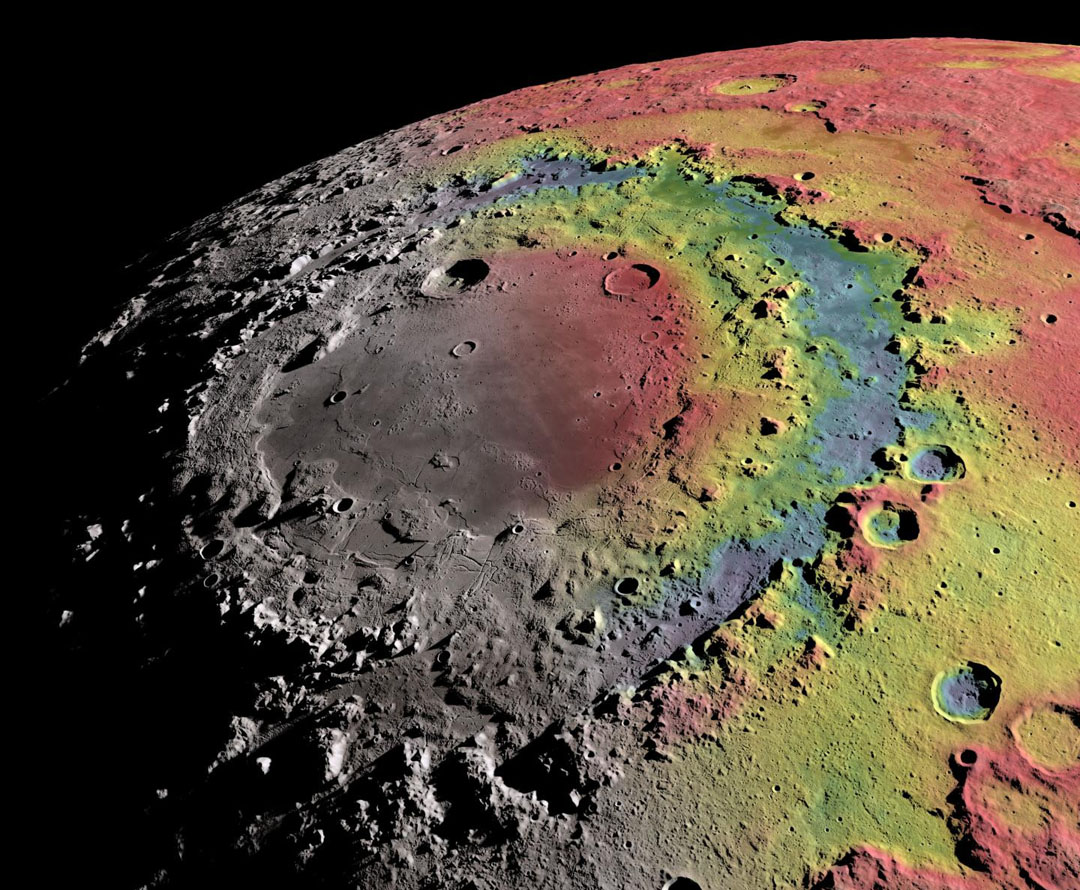
Ernest Wright / NASA-GSFC Scientific Visualization Studio
If you’ve never observed the Mare Orientale bull's-eye, the Moon's youngest and best-preserved impact basin, don't kick yourself. Despite being 930 kilometers (580 miles) across, the mare straddles the Moon's southwestern limb, where foreshortening often “compresses” it out of sight. This little-sailed sea only comes into its own when a favorable libration periodically swivels it into view. Fortunately, that happens this month.
We only see the lunar nearside because the Moon’s rotation period is exactly synchronized with its period of revolution. It turns at the same rate that it revolves, with one side facing Earth. This would seem to imply that only 50% of its surface is visible, but thanks to librations — the cyclic north-south nodding and east-west rocking of the Moon — the actual amount is 59%.

Tom Ruen
Libration Liberation
“Nodding” or libration in latitude occurs because the Moon’s orbit is inclined 5.1° to the plane of Earth’s orbit, and its axis is tilted 1.5°. Every lunation, the Moon ducks below and then above the Earth-Sun line, letting us peer under the south pole and over the north pole an additional ±6.5° (5° + 1.5°).
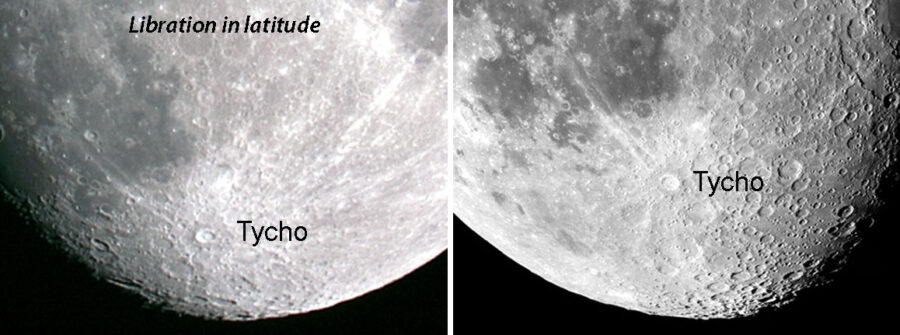
Bob King
“Rocking” or libration in longitude is a consequence of the Moon’s elliptical orbit. The Moon speeds up when it’s closer to the Earth and slows down when it's farther away. Since its rotation speed remains constant throughout, the two get out of sync. After perigee, the Moon’s swift orbital motion outpaces its rotation, exposing a slice of the far side beyond the trailing (eastern) limb. After apogee, the Moon’s orbital motion lags behind its rotation, and we see farther around the leading (western) limb.
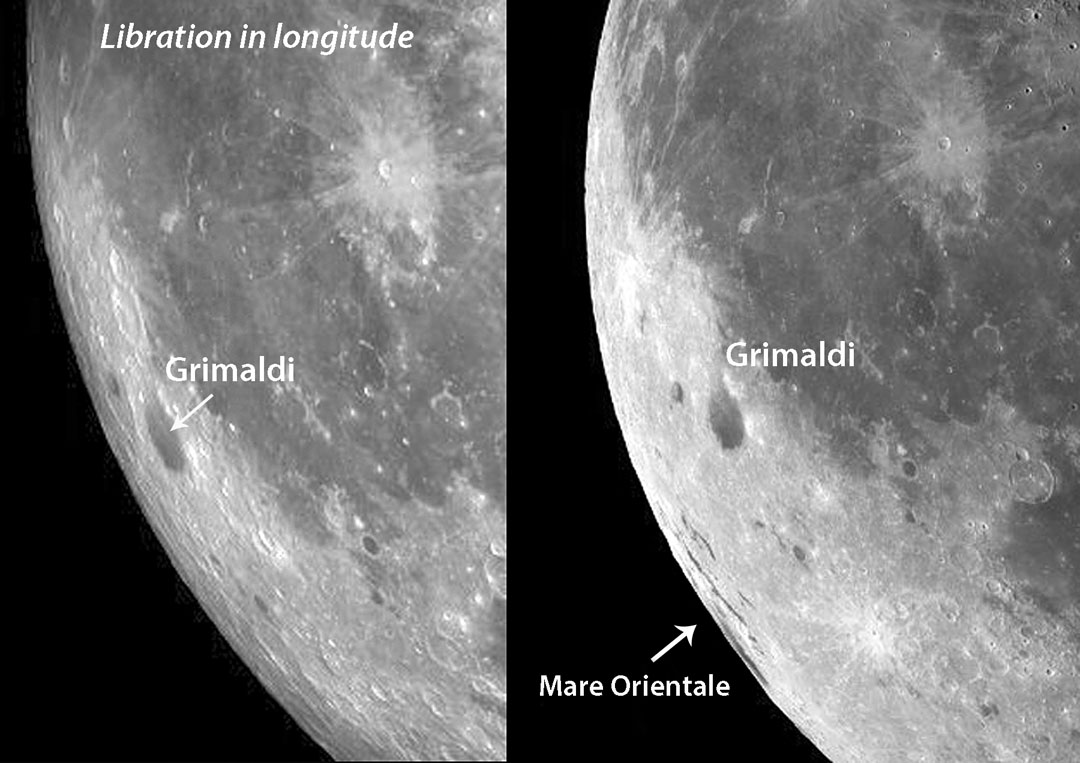
Bob King
Maximum librations occur about a week after perigee and a week after apogee, when observers can see up to 8° of longitude beyond either limb. Both types vary in amount from one lunar cycle to the next. Diurnal libration, caused by the difference in perspective when we view the Moon at rising vs. setting, exposes an additional ±1° of (mostly) longitude.
East Meets West
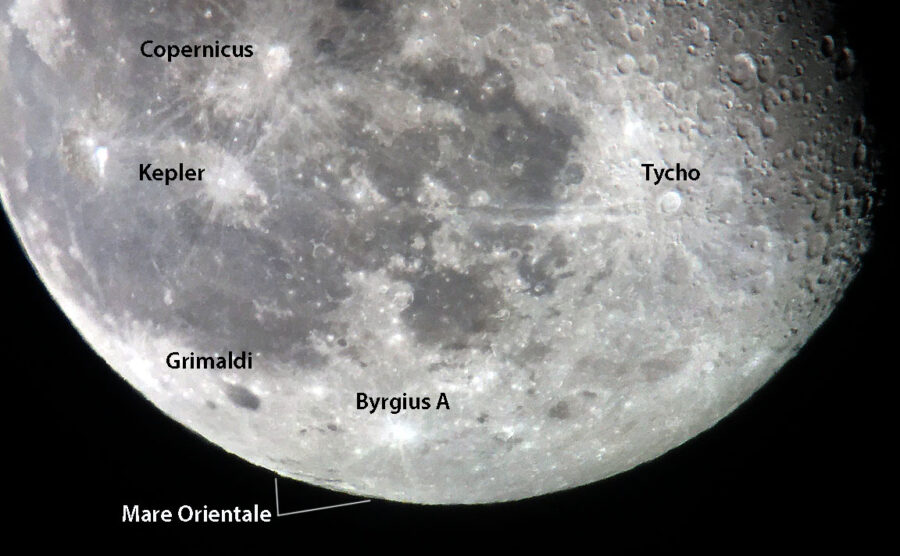
Bob King
Mare Orientale translates to the “Eastern Sea,” which seems a bit odd since it sits on the Moon’s western edge. Shouldn't it be called Mare Occidentale? More than a century ago, when astronomers first studied the mare in detail, convention defined the eastern part of the Moon as the side facing east as viewed from Earth. In 1961, the International Astronomical Union adopted a more universal definition, defining east and west from the viewpoint of someone standing on the Moon, the same way we determine directions on Earth.
Because Mare Orientale lies in the Moon’s southwestern quadrant, two conditions must be met for a good look at it: The southern and western libration extremes need to coincide, and the southwestern limb must be in sunlight. Note that libration doesn’t depend on the Moon's phase — it does its work whether or not your target is in daylight or darkness.
Travel Links Directory
Astronomers estimate that an asteroid about 40 miles (64 km) across crashed into the Moon around 3.8 billion years ago and excavated the huge Orientale basin. The tremendous energy generated in the impact partially liquefied the crust. Concentric waves of molten rock spread outward from the epicenter similar to the expanding ripples of water when you toss a pebble into a pond.
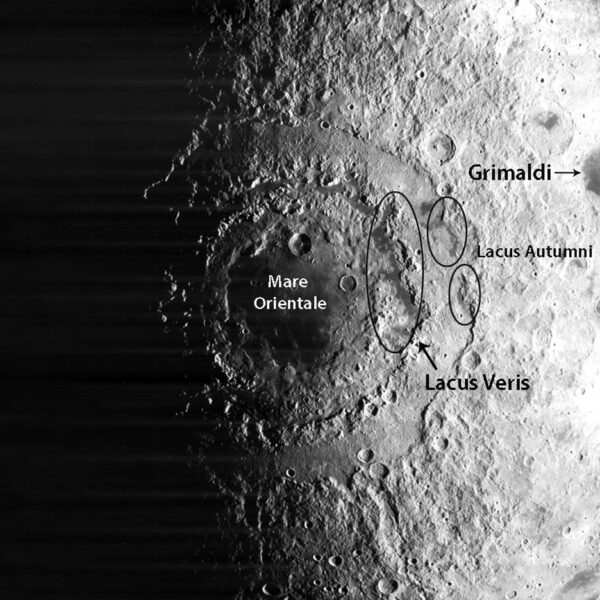
NASA
The rock solidified to form three nested, raised rings — the inner and outer Montes Rook ranges and the Montes Cordillera — separated by smoother lava plains that together form an enormous bull’s-eye. Were it located closer to the center of the lunar disk, Mare Orientale would compete with Tycho as one of the Moon’s most arresting sights. While the odds didn’t shake out that way, a favorable libration and a little imagination will go far in appreciating the mare’s impactful magnificence despite its out-of-the-way location.
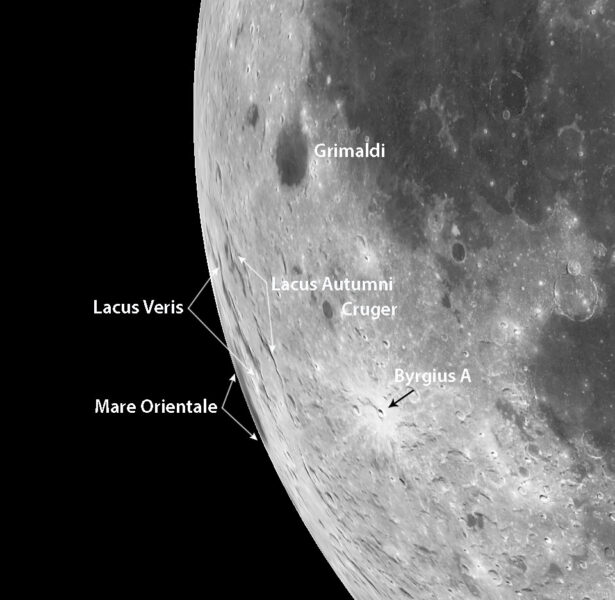
Virtual Moon Atlas / Patrick Chevalley, Christian Legrande
Viewing Guide
From January 19th to 23rd, longitudinal and latitudinal libration extremes join forces for one of the best views of Mare Orientale this year. Within that interval the peak nights are January 20th and 21st, when the Moon will be in waning gibbous phase and well placed for viewing after 10 p.m. local time. A 3-inch or larger telescope should be all the glass you need.
To get there, start at the prominent, dark-floored crater Grimaldi and look two Grimaldi-lengths southwest for a pair of narrow, dark stripes not far from the lunar limb. These are sections of the ring-shaped lava plains that occupy the lowlands between Orientale’s rugged peaks. They look stringy because you’re seeing them virtually edge-on, like Saturn’s rings.
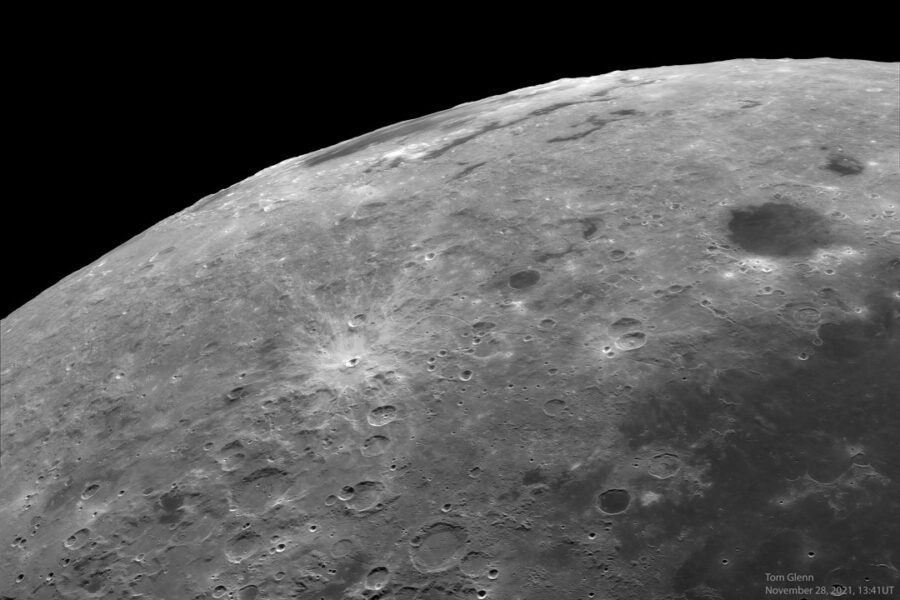
Tom Glenn
Unsqueezing a Sea
The outer stripe, named Lacus Autumni (“Lake of Autumn”), is closest to Grimaldi and composed of several separate segments that together form a broken arc. Lacus Autumni separates the Montes Cordillera from the outer Rooks. Interior to this stripe you'll spot the longer, continuous thread of Lacus Veris (“Lake of Spring”), located between the inner and outer Rook ranges. Farther south and just inside the lunar limb, look for a third, lens-shaped gray patch. That’s Mare Orientale — ground zero! Keep going — a white “thread” exactly at the limb is the ultra-foreshortened western half of the inner Rook range!
If you run into a cloudy spell, two additional windows of opportunity are open this year: February 17–18 and December 14–18. During next month’s apparition, sunrise at the mare occurs on the night of February 16th, highlighting the 3D topography of the outer mountain belts similar to the view in the photo below.

Michael Karrer
You can simulate the Moon’s every nod and waver (and identify hundreds of craters and other features) with the Virtual Moon Atlas. It’s my fave. Once you’ve downloaded and installed the software, be sure to click on Show Moon’s Phase under Configuration / Display so you know whether your chosen feature is in shadow or not.
The monthly issues of Sky & Telescope list select librations in the Lunar Almanac column (page 42), and NASA’s Dial-A-Moon and Moon Phase and Libration 2022 are also useful for checking libration extremes. Finally, the RASC Observer’s Handbook lists libration values in its monthly calendar. By convention, north and south librations are labeled with a plus (+) and minus (-), respectively. Longitudinal librations are positive (+) for east and negative (-) for west.
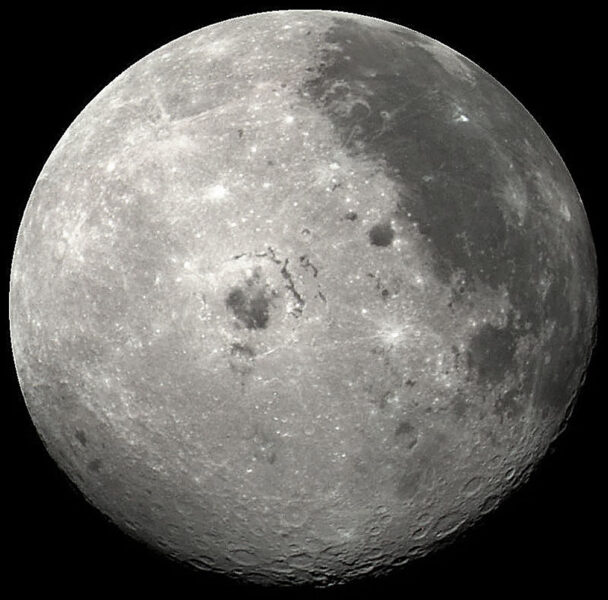
NASA / JPL
Rare Sights
On average, a complete cycle of lunar librations takes about six years. But that doesn’t guarantee you’ll necessarily see any lunar feature under the same lighting conditions tonight and six years hence, since librations aren't tied to phase. It’s possible your target could be in shadow on that future date.
In fact, one full Saros period (18 years, 11 days, 8 hours) must elapse before you see a crater, peak, crack, or mare under nearly identical libratory conditions and illumination. Practically speaking, views are extremely similar several times a decade. But essentially, every time you look at the Moon, you're seeing it like you never have before. What a great reason to get out and observe!
 21
21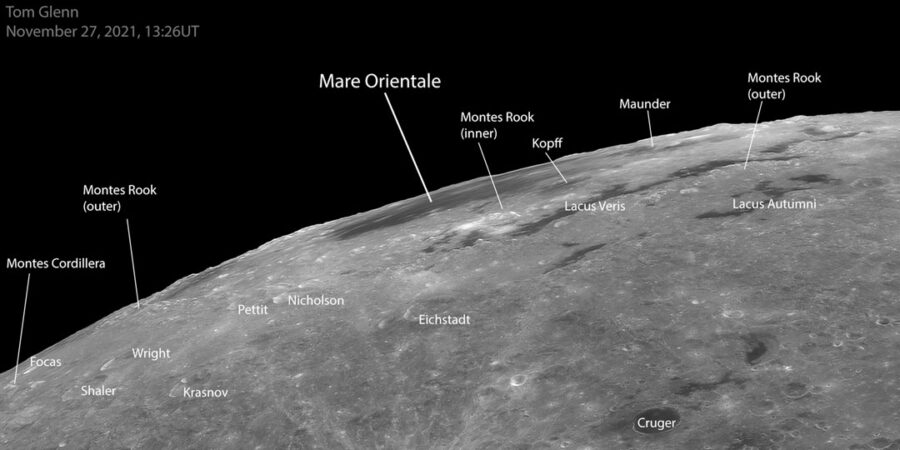









Comments
Andrew James
January 19, 2022 at 4:55 pm
A brilliant original lunar article. Thanks Bob.
You must be logged in to post a comment.
Bob KingPost Author
January 19, 2022 at 8:58 pm
Dear Andrew,
Thank you for your very kind words. I hope you're able to enjoy a good look at Mare Orientale during its current apparition.
You must be logged in to post a comment.
Russ
January 20, 2022 at 12:45 am
Very nice article, Bob. I had a look in the area just before full Moon this month, but before Mare Orientale was visible. I Remember Grimaldi and Kruger as two dark floored craters. I hope to have clear skies for some of the times mentioned for a good view of this mare. My Moon observation notes do not mention seeing Orientale, just some craters in the vicinity. Tonight (Jan 19th) isn't clear. But the next two nights are supposed to be clear. I hope I can muster up enough enthusiasm to get out a bit later in the evening to see Orientale. It has gotten harder for enthusiasm since I'm pushing 76 years. But shorter observing sessions are still in the mix. Thanks for the encouragement to observe the Moon. There's always something new to see.
Best Regards,
Russ
You must be logged in to post a comment.
Bob KingPost Author
January 20, 2022 at 10:50 am
Hi Russ,
Thank you — I'm glad you enjoyed the article. I hope you're able to get out for a look. Last night, it was really cold here with -6° and winds. I didn't exactly want to set up the scope, but clouds had prevented me from seeing the asteroid 1994 PC1 the previous night, so I gave it a go. Once I made the commitment it was easy. Within a few minutes I tracked down the object (still moving pretty fast!) and then went over to the moon for a look at Mare Orientale. It was a satisfying half-hour of observing, and oh, how nice to come inside after!
You must be logged in to post a comment.
shashikolar
January 20, 2022 at 3:48 pm
Thank you for the article Bob.
I had excellent views of the eastern portions of the lava "sea" of the Mare Orientale tonight. The dark stripe of the mare was easily visible today at both 133x and 300x, unlike yesterday where I failed to see any significant trace at 133x.
Thanks,
-Shashi
You must be logged in to post a comment.
Bob KingPost Author
January 20, 2022 at 7:41 pm
Hi Shashi,
I'm delighted to hear you were able spot the Orientale, in particular the mare itself, located so close to the lunar limb. Congratulations!
You must be logged in to post a comment.
Anthony Barreiro
January 22, 2022 at 6:41 pm
They're addictive. And you can even use them during the day to look at birds, etc. 😉
You must be logged in to post a comment.
Lucinda
January 20, 2022 at 4:37 pm
Am I the only person who likes to observe the moon during the day? This morning at 7:00 it was clearly visible out my west window and it was easy to set up my small telescope and get a good look. Mare Orientale was clearly visible, and it was fun to read this article so soon after observing it and get confirmation about what I'd just seen. Assuming the sky is clear tomorrow morning I'll be back at it, but this time I'll know a lot more about what I'm looking at. Thanks for a well-timed article!
You must be logged in to post a comment.
Bob KingPost Author
January 20, 2022 at 7:44 pm
Hi Lucinda,
You know, that's a great idea — observing the moon in daylight this time of year. The phase is just right for a great view in the early morning before the Sun gets too high. Happy to know the article popped up at just the right time for you!
You must be logged in to post a comment.
Anthony Barreiro
January 21, 2022 at 6:05 pm
I observed the Moon with 10x42 image-stabilized binoculars after sunrise this morning. Mare Orientale was easily perceptible as a dark imperfection on the Moon's bright limb. After a stretch of cloudy weather, last night and this morning were very clear here in San Francisco. I looked at the Moon last night and before and during dawn this morning. The best view of Mare Orientale was after sunrise -- there was no glare of moonlight against the blue sky.
I was also able to see Ceres (maybe for the last time during her current apparition, she is fading fast) and Iris with the binoculars last night.
I love those binoculars for impromptu urban skywatching. Just pop outside, look up, and press the button to stabilize the view.
Thanks Bob for all the timely heads ups. I appreciate that they're not all faint fuzzies, you can see quite a bit through light pollution if you know what to look for.
You must be logged in to post a comment.
Bob KingPost Author
January 21, 2022 at 11:56 pm
Hi Anthony,
How nice to know you were able to detect Mare Orientale with just 10x binoculars! Image stabilization helps. I'm hoping this year to buy a pair after spending time on board a pitching cruise ship trying to observe deep-sky objects in the southern Milky Way last fall.
You must be logged in to post a comment.
mary beth
January 24, 2022 at 1:17 pm
So happy you were able to see the sea and Ceres and Iris! Good work! pretty impressive way to start off the new year
You must be logged in to post a comment.
Ludovicus
January 23, 2022 at 7:16 pm
Hey Lucinda! Nice job on that!
I grabbed Mare Orientale a couple of years ago in October and did this during morning hours with my Stellarvue 90 Triplet APO and Leica Zoom EP.
I frequently employ a polarizing filter to help darken the skies even more! It was amazing. This year, we've been pretty plagued with weather systems blowing and snow all around - not the best for astronomy! lol
Besides great lunar views in daytime, you should try for some planets too! I bagged Venus in my 10x52 Minox Binoculars the other day just after mid-day and it was easy to see the 5% lit crescent. Scope would be easy to use for those observations as well.
Nice to see another daytime observer here! There's an extra nearly 1/2 day to explore the skies! 🙂
Cheers,
Darren H
Winnipeg MB Canada
You must be logged in to post a comment.
Rod
January 20, 2022 at 11:22 pm
I did get out view this pencil thin line along the lunar limb tonight 🙂 Observed 2130-2230 EST/0230-0330 UT. Full Moon 17-Jan-2022 2348 UT. Waning gibbous Moon tonight in Leo, close to 9-degree angular separation in sky position from Regulus. Mare Orientale viewed tonight using my 90-mm refractor with Moon filter and 14-mm eyepiece at 71x. Grimaldi distinct and easy to see, Riccioli and Byrgius A crater with ray patterns. Mare Orientale a thin pencil line along the lunar limb tonight, libration visible. I used the Virtual Moon Atlas to help identify other craters in the area. Virtual Moon Atlas shows the lunar diameter tonight ~ 30.75 arcminutes. My telescope true FOV at 71x just a bit more than one-degree or 60 arcminutes. At 71x the angular resolution ~ 4.2 arcseconds so the Moon distance near 389000 km according to Virtual Moon Atlas, ~ 8 km diameter area on the Moon resolved. One arcsecond resolution ~ 1.89 km diameter area on the Moon. Temperature -4C, winds 360/8 knots when I viewed. Earlier today some light snow. This evening when I viewed, bands of cirrus and altocumulus clouds moved by. Coming back inside, the wood burning stove felt very good.
You must be logged in to post a comment.
Bob KingPost Author
January 21, 2022 at 2:42 pm
Hi Rod,
I knew you'd get out there for a look. Thank you for sharing your observation. My favorite winter nights are also the ones where I return to the good heat from our wood burning stove.
You must be logged in to post a comment.
Sona Shahani Shukla
January 21, 2022 at 3:27 am
Hi Bob,
Thank you for this wonderful article, I managed to get a glimpse of it and imaged it as well. It's not great quality but am quiet happy with what I could manage from Delhi Skies which are marred with dense fog these days. Clear Skies!
You must be logged in to post a comment.
Bob KingPost Author
January 21, 2022 at 2:44 pm
Hi Sona,
You're very welcome, and thank you for saying. It makes me happy that you were able to see it. Thank you for writing and sharing your observation.
You must be logged in to post a comment.
mary beth
January 22, 2022 at 12:24 pm
Bob this article is beautifully written and so very interesting! Thanks to Rod for linking me to this!
You must be logged in to post a comment.
Bob KingPost Author
January 22, 2022 at 11:14 pm
Hi Mary Beth,
Thank so much for saying! I hope you get to see this most interesting if "edgy" sight.
You must be logged in to post a comment.
AndrewMyl
January 23, 2022 at 5:47 am
Thank you Bob for such a brilliant article. It enriched my viewing experience so much . Had a productive night yesterday by getting to see all the key features like Lacus Autumni, Lacus Veris, Mare Orientale and the western half of the Inner Rook right at the limb. What a sight that was. I also loved the fact that Cruger, Darwin and Byrgius forms a triangle with Darwin pointing towards the Bullseye. Was trying to view Rimae Focas but unable to. My setup: 130mm Skywatcher Heritage with a Planetary 5mm eyepiece.
You must be logged in to post a comment.
Bob KingPost Author
January 23, 2022 at 11:36 am
Hi Andrew,
I'm tickled you were able to see so many different aspects of the Orientale basin. Congratulations! Good idea to make a crater "asterism" as a quick-point guide to the mare. Thank you for writing, and I wish you many more lunar adventures.
You must be logged in to post a comment.
You must be logged in to post a comment.